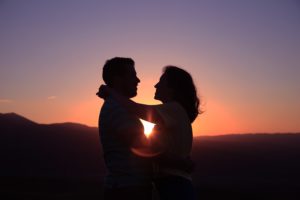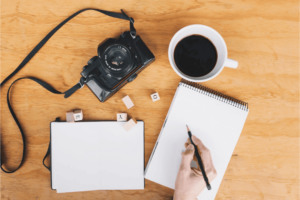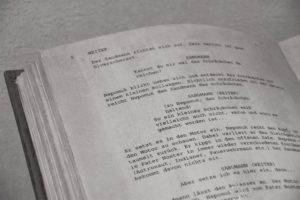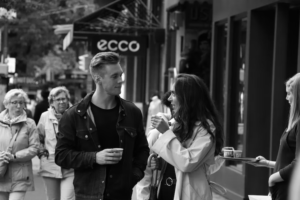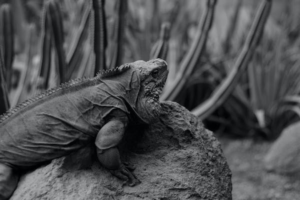A wide shot (WS for short) is a type of camera shot where a character or group of characters is completely within the frame. Wide shots are also referred to as long shots or full shots, and filmmakers use this type of cinematic scene-building to give the audience the context, space, scale, or distance of the subject or subjects in the scene. Filmmakers also use wide shots to give the audience a full view of other important features of the film, not just the characters.
Types of Wide Shots
If you’re developing your cinematography skills, the wide shot is an essential element to include in your projects. There are several types of wide shots that fit into a film, and you can use them based on the scene you’re filming, the context of the story, and how you want to portray your characters.
Very wide shot (VWS)
In a very wide shot, the camera is set much further away from the character or subject in the film than the wide shot, but not so far away that the audience can’t see who the character is. In a very wide shot, the character or subject is just visible in the scene within the film’s environment or setting. Very wide shots help the audience orient themselves with the setting of the film and how the character fits into it.
A great example of this comes from the World War 2 movie “Dunkirk” during the dogfight scenes between the Allies and Axis Powers in the air. The wide shot, in this case, is necessary to build context for the audience so they can have the full scope of the planes battling above the beach.
Extreme wide shot (EWS)
In an extreme wide shot, you can barely see the subject of the scene. In the case of introducing and showing characters, an extreme wide shot shows the audience exactly where the story takes place and sets up the tone of the setting, making the characters’ environment an integral part of the story.
The film “Forrest Gump” shows an extreme wide shot during the beginning where Forrest Gump sits on the bench and begins talking. The extreme wide shot is seen from above the characters, so the audience gets an idea of where they are sitting, what the setting looks like, and how that affects the story Forrest Gump tells.
Establishing shot (ES)
An establishing shot is a wide shot that is typical of opening scenes to give the audience context of the film’s setting and tone and can even be used to foreshadow the characters’ story arcs. These shots help the audience understand what the timeline is, the geographic location of the story, and to introduce integral characters.
An example of an establishing shot would be any time we see Hogwarts castle from afar in the “Harry Potter” films. We often see Hogwarts when Harry arrives there for the first time in each film, usually a welcome sight, and then get another shot of the castle toward the end of the film as he leaves, which is often cast in a different light and has a more bittersweet feeling.
Master Shot
Master shots are wide shots that feature all of the important characters within a scene. It is typically one continuous shot as the scene unfolds. Some stories may hold on just the master shot during an entire scene, while others may cut to close-ups or other shots to show character reactions and emotions and even just to keep the scene dynamic for the audience.
One notable master shot is from the film “American Beauty.” The protagonist Lester, his wife Carolyn, and his daughter Jane sit for dinner in their exquisite dining room. The master shot captures all three of them at the table, with each parent on either end and Jane in the middle facing toward the camera. This master shot establishes who the main characters of the scene are, their relationships to each other with the parents separated and Jane between them, and their relationship to the setting. Such a well-balanced shot juxtaposes the heated argument that erupts in the scene.
When to Use Wide Shots
Since wide shots help the audience build a connection to the characters and the setting of a film, it’s important to understand when to use wide shots so you can build a story that audiences connect to. There are several instances where wide shots can be essential to highlight specific scenes within the storyline and help give context about the characters. Here are the moments when you should consider using a wide shot to tell the story:
- Establishing a new scene, location, setting, or timeline.
- World-building to the audience and/or characters, especially for science fiction, fantasy, and other movie genres.
- Introducing the main characters and subjects to the audience.
- Creating the tone and mood of the film’s plotline.
- Showing the depth of a character’s relationship or connection to the setting.
How to Frame a Wide Shot
When you get started developing your ability to film wide shots, there are a few methods you can use to improve the picture, tone, and context of the plotline. Here are several approaches to take when filming your wide shot:
- Center the frame by finding vertical and horizontal elements of the location and using them to level your wide shot. Light poles, fences, the ocean’s horizon, and other structures and landmarks can help you keep your frame centered, unless you want a tilt shot, or tilt effect, in the scene.
- Divide your frame into nine sections, also known as “the rule of thirds.” The frame should look like a Tic-Tac-Toe board after you separate it into the nine sections. Using these sections like a grid, position points and subjects of interest within the top third or two-thirds of the nine-part grid rather than directly in the center. For instance, with a character’s wide shot, their head should be toward the top of the frame and their feet and legs toward the bottom third of the frame rather than in the center.
- Create lead and headroom within the frame. Lead room refers to the empty space within a wide shot that gives the characters room to move forward or backward within the same shot. Headroom refers to the space between the top of the frame and the character’s head. In a wide shot, there should be some lead room left strategically empty to create a sense of direction for characters to move within. The headroom is the space above characters’ heads in the frame and is used to situate a character aesthetically in the frame. The amount of headroom can also indicate a character’s emotions during the scene, like their level of comfort or another emotion.
- Use lighting to create tone and mood within the shot. With the wide shot, you can show the audience the setting and get them to understand its importance to the story. Shadows, darkness, or dreary lighting can imply a foreboding scene, while bright and natural light can help set a joyous mood for the film.
- Avoid cutting subjects from the frame. If you have to cut an object from your wide shot, avoid cutting out parts, features, or sections of a character or their body. If you have to cut certain parts for the context of the shot, try to fit as much of the subject in the frame as you can and cut the shot at the subject’s joints, such as their knees or ankles.
Being able to create the perfect wide shot can help you fully immerse audiences into your visual stories. At the Nashville Film Institute, you will learn how to set up, shoot, and edit wide shots as well as develop the practical filmmaking skills you need to succeed in the industry. Contact the Nashville Film Institute for more information about applying.




